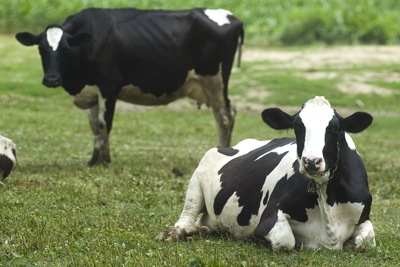Friday, July 23rd, 2010
What to do with the poo
Farmers manage 630,000 tons of waste annually
By Nancy Allen

Photo by Mark Pummell/The Daily Standard
Dairy cattle lounge in a field near St. Henry recently. The manure produced by the huge number of livestock operations in the Grand Lake Watershed has come under scrutiny as officials decide what to do about the lake's toxic algae.
GRAND LAKE - 20,600 beef and dairy cattle.
80,000 hogs.
168,000 turkeys.
3.75 million chickens.
629,504 tons of manure each year.
That's the Grand Lake Watershed.
How that manure is managed and where it ends up has taken center stage as nutrient-fed toxic algae blooms have plagued Grand Lake in recent weeks.
Officials trying to find a solution to the lake's algae issue agree it's a problem that has been years in the making.
Though there are many sources of nutrient loading to the lake, the biggest is runoff from farmland - 80 percent of the acreage in the watershed.
Terry Mescher, an agricultural engineer with the Ohio Department of Natural Resources, was brought to the watershed in May of last year to help farmers do their part toward a fix. He is one of four core team members giving farmers technical assistance and registering them for government programs that pay part of the costs to implement conservation practices.
The amount of livestock has tripled in Mercer County in the last 50 years, but there are no official stats on the increase in the watershed. Most of the livestock is in the southern portion of the county, as is most of the acreage in the watershed.
Poultry not the problem
Mescher said the biggest increase has been poultry, but their waste is not an issue. Ninety percent of the chicken and 75 percent of the turkey manure is exported out of the area by brokers. Brokering poultry litter from the watershed began about 10 years ago and has increased steadily.
"About two years ago, we estimated poultry farmers were exporting about 90,000 tons of poultry litter out of the watershed," he said.
Crop farmers want poultry manure because it costs less than commercial fertilizer and has a high nutrient content.
Dairy and hog manure generally is not sold or moved out of the watershed because it's cost prohibitive, Mescher said. Typically in liquid form, it is hard to handle and not economical to broker because it can contain up to 95 percent water. The liquid manure continues to pose the most challenges, he said.
Transporting liquid hog manure short distances (6 to 10 miles) can cost between 1.5 to 3 cents per gallon, which in many cases is more than the nutrients are worth, he said. Between 3,000 to 5,000 gallons is needed to fertilize an acre, Mescher added.
Even with poultry taken out of the equation, there still would be enough manure produced in the watershed to fertilize 46,000-48,000 acres - roughly the same number of crop acres in the watershed, Mescher said. That would be ideal if the land needed the nutrients, but it doesn't. Many fields - which have had decades of manure and commercial fertilizer application - already have phosphorous levels so high that no further application is recommended, he said.
Phosphorous, more than any other nutrient, does the most to promote the lake's blue-green algae growth, said Laura Walker, coordinator of the Grand Lake-Wabash Watershed Alliance.
Mescher said the best thing farmers can do to help the lake is move manure out of the watershed. The second best option - plant winter cover crops.
Cover crops, manure storage
Farmers typically spread manure after fall crops have been harvested and bare ground makes manure more prone to runoff. If cover crops are planted after harvest they can take up nutrients and lessen runoff.
Cover crops can be costly to plant and require close management. However experts say the benefits are increased soil structure and yields, if done correctly.
Emergency funding from the federal government became available this week and farmers can apply for a portion of $1 million in USDA money from the Environmental Quality Incentives Program. Priority will be given to applications requesting funds for transporting manure and planting winter cover crops.
More farmers also need to install manure storage structures, according to Mescher. They should allow for at least six months storage so manure can be spread when most environentaly appropriate, he said.
"If we can't store your our manure properly, we can't manage it properly," Mescher said. "Fifty years ago the common way to manage it was you scraped it and hauled it every day. If you're doing that on frozen or snow-covered ground, that's not good."
It is legal for nonpermitted farms to spread in the winter, though it is not recommended.
"Our position is we would hope producers would have a crop rotation that they would have ground available for application in August, September and October," Mescher said.
Moving forward
Local ag officials say strides are being made. Record numbers have signed up for conservation practices, including the installation of grass waterways to slow down runoff, construction of manure storage facilities and the planting of cover crops.
Farmers have realized the gravity of what is going on in the watershed and are correcting problems and actively looking for help, Mescher said.
Mescher said his team is having difficulty keeping up with the high number of producers signing up for conservation funding at the Mercer County Soil and Water Conservation District office. Funding for manure storage facilities is the top request.
In the past two years, $2.5 million in (EQIP) have come to the watershed for farmers. One million dollars was distributed last year. Another $1.5 million arrived in April and has been allocated. An additional $1.5 million in applications was received at that time but could not get funded, Hawk said.
While the farming community is taking action to stop current nutrient loading to the lake, not much can be done about the accumulation at the bottom of the 13,500-acre man-made body of water - aside from dredging it, experts say.
"Grand Lake was built (1837 to 1841) at a time when Mercer County was being developed and settled and sediment and nutrients in the bottom of the lake are the accumulation of not just years, but over a century of all types of runoff," Mescher said.
Watershed farmer Dave Rawers said farmers are anxious over the attention that's been directed at them and the watershed. He attended a meeting last week where farmers were told to "step up" or possibly face stricter ag regulations, including a ban on wintertime manure application.
"They're worried about the state outlawing that. Other states have laws against it already," Rawers. "That would be a concern for farmers here."
Rawers has used government funds to install a wetland to treat his milkhouse wastewater. He plans to build another to help absorb runoff from his manure yard.
Setting an example
The Lake Improvement Association in a letter to Ohio Gov. Ted Strickland made numerous requests for action to help the lake, including prohibiting the expansion of existing livestock farms.
LIA President Tim Lovett said his group isn't against expansion, as long as it's done responsibly using best management practices that keep manure on farmland and out of the lake.
"We are at a point where we're way past the blame game. We know what the issues are, now we need to get results," he said.
Lovett said he is aware of the strides farmers are making. He noted Grand Lake isn't the only watershed with these water quality issues. In the end, it's going to take multiple people and agencies working collaboratively to improve the lake, he said.
"If we can't get it right in this very small watershed, what are our hopes of getting it right in the Lake Erie and Mississippi watersheds. They are seeing the same things," he said. "We could become a positive example of what could be done when people address issues and produce results."
Text edited as marked July 26, 2010.


